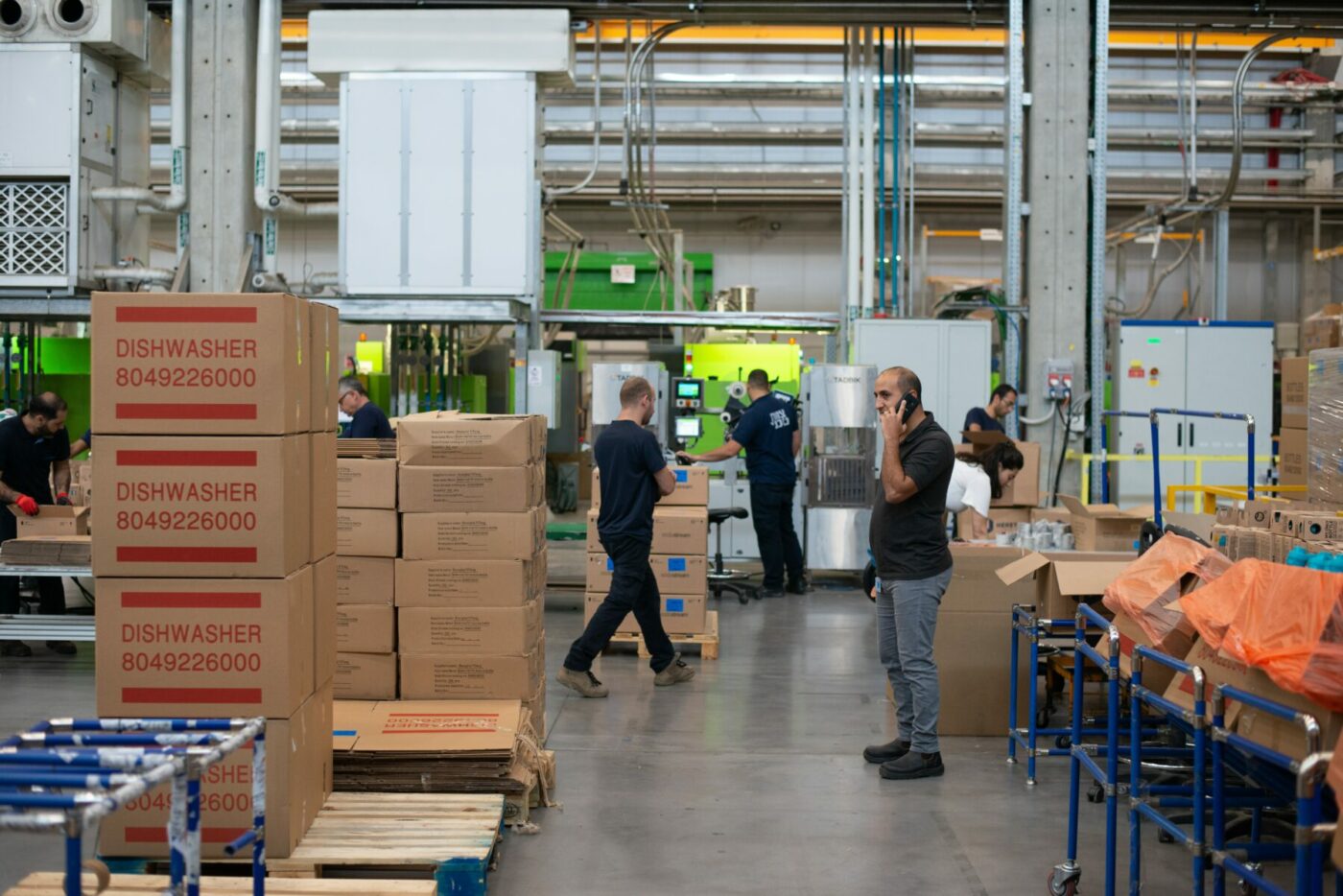In warehousing, proper lighting solutions are important. Customized warehouse lighting options help to illuminate the spaces effectively and also play a key role in ensuring safety, minimizing energy expenses, and boosting productivity. Implementing high-tech LED lighting in warehouses is an important milestone towards operational effectiveness and sustainability.
Table of Contents
ToggleThe Flexibility of Advanced Warehouse Lighting Solutions
Modern LED systems provide unparalleled flexibility to warehouse lighting. They make it easy to adapt to every section of a warehouse with features like remote management and motion sensor lighting, which can help reduce energy consumption. This adaptability is complemented by automatic brightness adjustments, which ensure constant lighting levels and considerably increase energy efficiency.
LED lights can adjust illumination to individual needs, which is crucial in warehouses where different areas require lighting at varying levels.
Safety Enhancements with LED Lighting Solutions
Advanced LED lighting solutions in warehouses have safety features beyond just providing light. These lighting systems transform safety protocols, dealing with multiple issues of concern in warehouse settings.
First of all, the stable and flicker-free nature of LED lighting minimizes eye strain and fatigue among workers, which is a common experience with regular fluorescent lights. This factor is critical in warehouses where employees need to be alert and focused since fatigue of the eye can cause errors or accidents.

LEDs improve clarity. They can provide light quality that is nearer to natural daylight, improving color perception and visibility of detail. This is especially significant in the warehouses where there are installed identification systems based on items and color codes. Better visibility automatically means fewer accidents and mistakes, which translates to a safer working environment.
Another safety aspect of LED lighting is its minimal heat emission. Unlike traditional lighting solutions that can significantly increase the temperature in a facility, LEDs operate at a cooler temperature. This reduces the risk of heat-related incidents and contributes to a more comfortable working environment, which is vital in maintaining focus and reducing fatigue-related errors.
Moreover, LEDs are robust and less prone to damage. This durability is essential in active warehouse settings where lights may be subject to vibrations or incidental contact with machinery or equipment. Their resistance to breakage means reduced maintenance and lowers the risk of accidents related to shattered or malfunctioning lights.
LEDs also offer environmental safety advantages. They do not contain hazardous substances like mercury, found in some traditional bulbs, and emit negligible UV and IR radiation, which can be harmful over prolonged exposure. This makes LED lighting a safer choice for both workers and the environment. These factors contribute to why LEDs are the best warehouse lighting solutions.
Learn more: Industrial LED Flood Lights: Essential for Safety and Efficiency in Workplaces
Customization in Lighting Solutions
Customization of lighting solutions in warehouses has become one fundamental characteristic of LED technology. LED lights provide various possibilities of personalization, with the ability to dim and different color temperatures for variation in tasks or operational areas within a warehouse.
Learn more about how to properly survey a warehouse for LED
Adaptability further improves with the use of advanced control systems that not only enable remote monitoring but also scheduling and dynamic adjustment of lighting based on specific requirements. Such a level of customization not only perfects operational efficiency but also assists in energy management by enabling warehouses to adapt to changing needs and boost their energy use quickly.
Comparing Lighting Options for Warehouses
The differences between HID, Fluorescent, and LED are important in the case of lighting used for warehouses. HID and fluorescent lights were typical for warehouses until recently; however, LEDs are now gaining the upper hand in energy efficiency and luminosity. LEDs are better lit, consume less energy, and last much longer. This makes them a more environmentally friendly and cost-effective alternative to modern warehouses.

The ability of LED lights to provide instant illumination, along with their durability and resistance to external impacts, makes them particularly suitable for the challenging warehouse environment. These factors combine to make LED lighting the preferred choice for enhancing visibility, reducing energy costs, and improving overall safety in warehouses.
The Future of Lighting Solutions in Warehouses
Continuous advancements in LED technology shape the future of lighting solutions in warehouses, promising greater energy efficiency and adaptability. Here are some key trends and developments:
- Smart Lighting Systems: Integration of IoT (Internet of Things) technologies is leading to intelligent warehouse lighting systems that can be controlled remotely and adapted to environmental factors. These systems can react to real-time data inputs like occupancy levels, daylight availability, and traffic patterns, optimizing energy usage and enhancing overall operational efficiencies.
- Human-Centric Lighting: This is an idea of lighting that imitates natural daylight patterns and has a positive effect on employee well-being, moods, and productivity. These lighting solutions are intended to align the workers’ natural circadian rhythms, promoting warehouse efficiency and their well-being.
- UV Disinfection and Therapeutic Lighting: Innovations include the addition of UV-C light sources in lighting fixtures for disinfection and the provision of therapeutic services, including red light therapy. These dual-concept solutions improve safety and hygiene levels as well as offer non-intrusive treatment of different health conditions.
- Enhanced Energy Efficiency and Sustainability: LED technology continues to evolve with a focus on maximizing lumens produced per watt of power, thereby reducing energy consumption. This is in line with sustainability goals due to increased efforts on thermal management systems and the use of recycled materials for improved environmental friendliness LED fixtures are now being made.
- Emergency and Backup Lighting: Advances in LED technology now provide viable emergency and backup lighting solutions. These systems can activate automatically during power outages, ensuring safety and reducing maintenance costs while being more cost-effective and reliable than traditional backup lighting options.
- Customization and Versatility: Advances in optics allow high-performance LEDs to provide consistent and uniform lighting in various warehouse environments, including those with unique layouts or specific lighting needs. Features like tunable white lighting enable operators to change the color temperature of LED lights to suit different activities and times of the day, enhancing both visibility and comfort.
These trends indicate a shift towards more efficient, adaptable, and environmentally friendly lighting solutions in warehouses, emphasizing improving the working environment and operational efficiency. As technology continues to advance, these lighting solutions are set to become even more integral to warehouse operations.
Key Takeaway: Future warehouse lighting focuses on efficiency and adaptability, leveraging smart IoT systems, human-centric designs, and innovative LED technology for enhanced safety, energy savings, and operational effectiveness.
Conclusion
Warehouse lighting solutions provided by National LED signify a major evolution in warehouse operations. Our LED technology provides tailored lighting that addresses particular warehouse requirements, improving operations’ safety and efficiency. Motion sensor lighting, remote management and automatic brightness control are only some of the advanced features that can also help to save energy.
LED lights offer steady, flicker-free lampost and thus reduce eye-straining and heat emission, making the working environment safer and more comfortable for individuals. Smart, adaptive and energy-saving LED lighting systems integrated with IoT technology that combine human-centric light to create a proactive as well as sustainable environment would be the future of warehouse lighting solutions.








